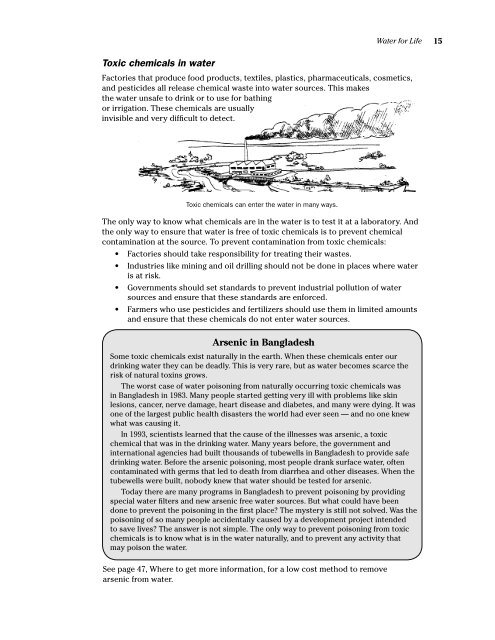Community water security - UN-Water
Community water security - UN-Water
Community water security - UN-Water
You also want an ePaper? Increase the reach of your titles
YUMPU automatically turns print PDFs into web optimized ePapers that Google loves.
<strong>Water</strong> for Life<br />
15<br />
Toxic chemicals in <strong>water</strong><br />
Factories that produce food products, textiles, plastics, pharmaceuticals, cosmetics,<br />
and pesticides all release chemical waste into <strong>water</strong> sources. This makes<br />
the <strong>water</strong> unsafe to drink or to use for bathing<br />
or irrigation. These chemicals are usually<br />
invisible and very difficult to detect.<br />
Toxic chemicals can enter the <strong>water</strong> in many ways.<br />
The only way to know what chemicals are in the <strong>water</strong> is to test it at a laboratory. And<br />
the only way to ensure that <strong>water</strong> is free of toxic chemicals is to prevent chemical<br />
contamination at the source. To prevent contamination from toxic chemicals:<br />
• Factories should take responsibility for treating their wastes.<br />
• Industries like mining and oil drilling should not be done in places where <strong>water</strong><br />
is at risk.<br />
• Governments should set standards to prevent industrial pollution of <strong>water</strong><br />
sources and ensure that these standards are enforced.<br />
• Farmers who use pesticides and fertilizers should use them in limited amounts<br />
and ensure that these chemicals do not enter <strong>water</strong> sources.<br />
Arsenic in Bangladesh<br />
Some toxic chemicals exist naturally in the earth. When these chemicals enter our<br />
drinking <strong>water</strong> they can be deadly. This is very rare, but as <strong>water</strong> becomes scarce the<br />
risk of natural toxins grows.<br />
The worst case of <strong>water</strong> poisoning from naturally occurring toxic chemicals was<br />
in Bangladesh in 1983. Many people started getting very ill with problems like skin<br />
lesions, cancer, nerve damage, heart disease and diabetes, and many were dying. It was<br />
one of the largest public health disasters the world had ever seen — and no one knew<br />
what was causing it.<br />
In 1993, scientists learned that the cause of the illnesses was arsenic, a toxic<br />
chemical that was in the drinking <strong>water</strong>. Many years before, the government and<br />
international agencies had built thousands of tubewells in Bangladesh to provide safe<br />
drinking <strong>water</strong>. Before the arsenic poisoning, most people drank surface <strong>water</strong>, often<br />
contaminated with germs that led to death from diarrhea and other diseases. When the<br />
tubewells were built, nobody knew that <strong>water</strong> should be tested for arsenic.<br />
Today there are many programs in Bangladesh to prevent poisoning by providing<br />
special <strong>water</strong> filters and new arsenic free <strong>water</strong> sources. But what could have been<br />
done to prevent the poisoning in the first place? The mystery is still not solved. Was the<br />
poisoning of so many people accidentally caused by a development project intended<br />
to save lives? The answer is not simple. The only way to prevent poisoning from toxic<br />
chemicals is to know what is in the <strong>water</strong> naturally, and to prevent any activity that<br />
may poison the <strong>water</strong>.<br />
See page 47, Where to get more information, for a low cost method to remove<br />
arsenic from <strong>water</strong>.
















